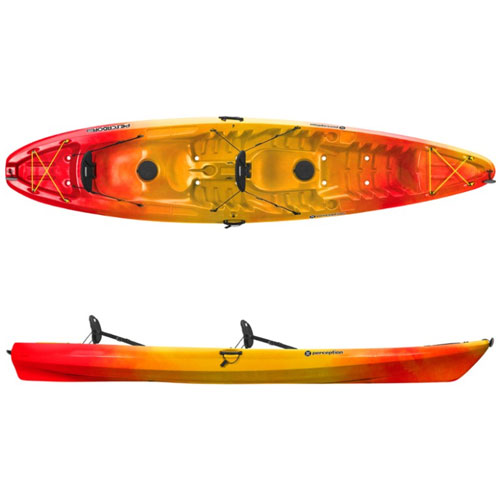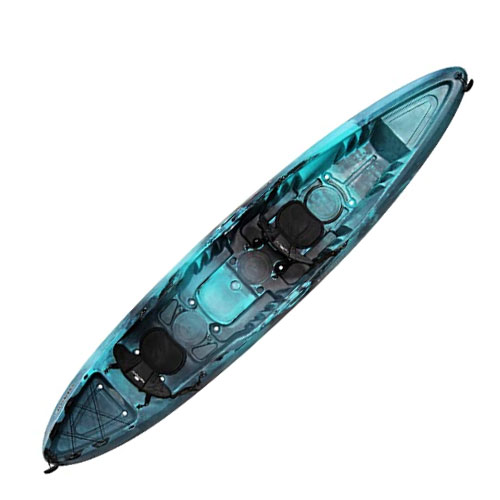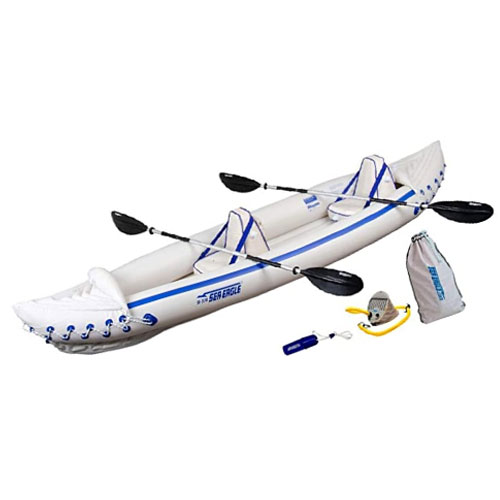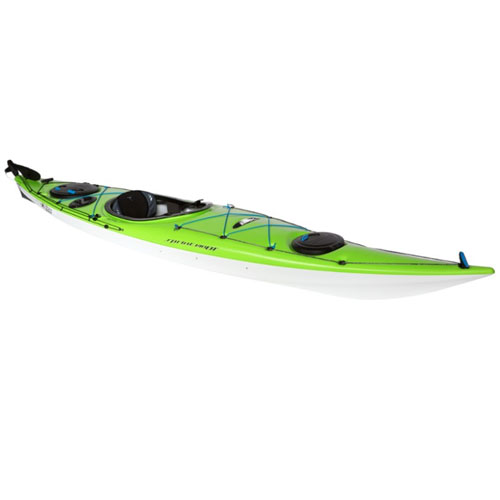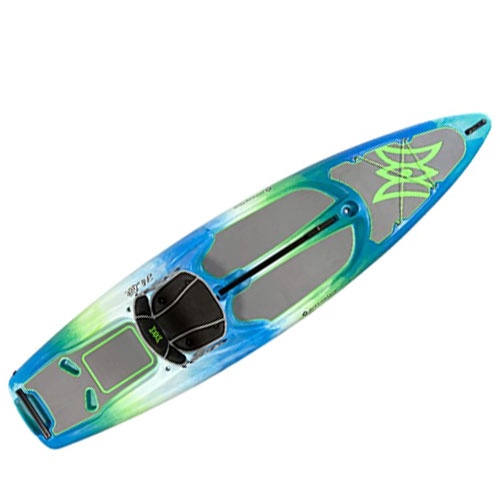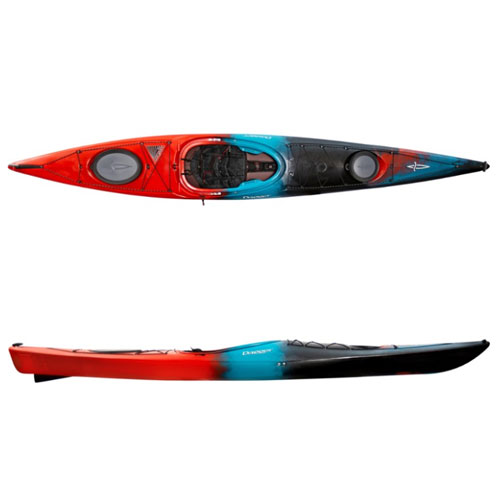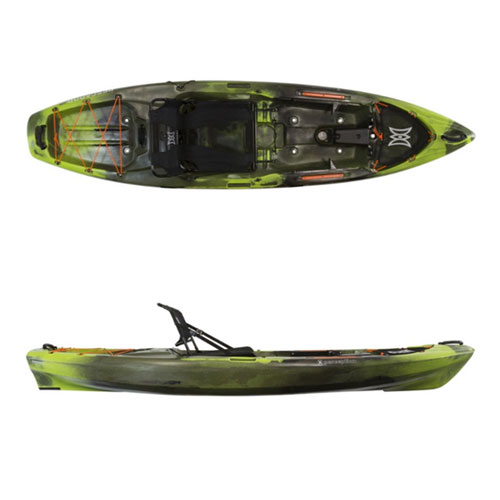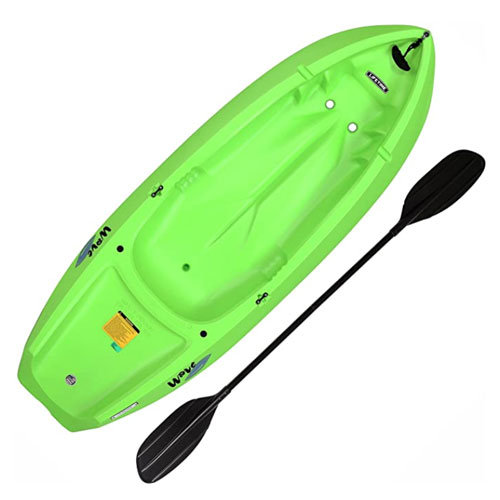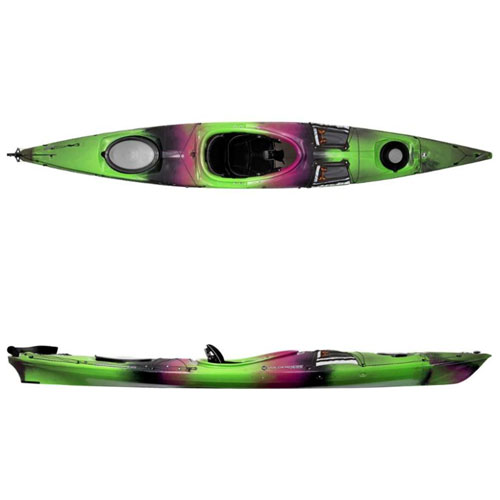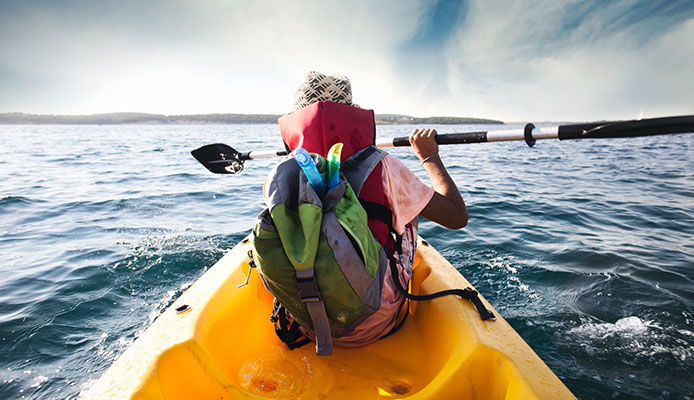
-
1.
-
2.
-
3.
-
4.
-
5.
If you enjoy venturing to the open water, a true ocean kayak will really boost your experience. Specifically designed for off-shore exploring, the best ocean kayaks will make your paddling sessions both safer and more comfortable.
To help you on your journey, this article reviews the best ocean kayaks on the market in detail (with all their pros and cons). On top of this, be sure to read the buying guide below and learn about what makes ocean kayaks so different from regular models.
Best Versatile Ocean Kayak
Perception Pescador Pilot 12.0 Pedal Kayak
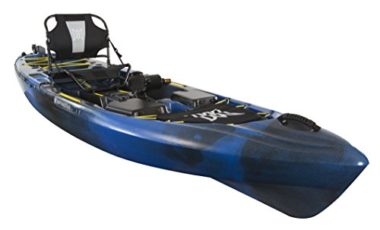
- Stand Out Features - Why We Love It
- Pilot Drive pedal system provides excellent propulsion
- Hand-controlled rudder for easy 360-degree turning radius
- UV-resistant polyethylene hull with fantastic durability
- Lawnchair-style Captain’s Chair seat for comfort
- Packed with fishing features (gear tracks, consoles, rod holders)
- High weight capacity
Length: 12 feet 5 inches
Width: 33.75 inches</span
Weight: 85 pounds
Material: High-Density Polyethylene
Capacity: 525 pounds
Paddlers: 1
Best Tandem Ocean Kayak
Perception Pescador 13.0 Tandem Sit-On-Top Kayak
- Stand Out Features - Why We Love It
- Tackles lakes and coastal waters equally well
- Comfort Seat system with thick breathable padding
- Two paddles included in the kayak package
- Each kayaker gets a small dry storage hatch
- Spacious bungee-corded tankwells in the front and back
Length: 13 feet
Width: 34 inches
Weight: 69 pounds
Material: High-Density Polyethylene
Capacity: 500 pounds
Paddlers: 2
Best Budget Ocean Kayak
Perception Rambler 13.5 Sit-On-Top Kayak
- Stand Out Features - Why We Love It
- Plenty of space for two large kayakers
- Best value ocean kayak on a budget
- Additional middle seat for a child or pet
- Large back tankwell easily fits a cooler
- Can be reconfigured to a solo kayak
Length: 13 feet 6 inches
Width: 34 inches
Weight: 78 pounds
Material: High-Density Polyethylene
Capacity: 550 pounds
Paddlers: 2
Best Inflatable Ocean Kayak
Sea Eagle SE370 Inflatable Kayak
- Stand Out Features - Why We Love It
- Plenty of space in the cockpit for three people and gear
- PolyKrylar hull with excellent dent and puncture-resistance
- I-Beam reinforced floor gives additional strength and rigidity
- Equipped with two skegs to improve tracking and speed
- Three deluxe one-way valves for easy inflation and deflation
- High weight capacity
Length: 12 feet 6 inches
Width: 32 inches
Weight: 32 pounds
Folded Size: 31 x 19 x 8 inches
Material: 38 mil PolyKrylar (K80 PVC)
Capacity: 650 pounds
Paddlers: 2 or 3
Best Ocean Kayak For Speed
Pelican Premium Sprint 140DT Kayak
- Stand Out Features - Why We Love It
- Fluid Steering System rudder for top-level maneuverability
- Keel extension increases secondary stability
- Premium RAM-X polyethylene with a resin top layer
- Front and rear bulkheads prevent kayak flooding
- Ergoflex G2 seating system provides all-day comfort
Length: 14 feet
Width: 25 inches
Weight: 55 pounds
Material: RAM-X Premium Polyethylene Plastic
Capacity: 300 pounds
Paddlers: 1 person
Best 2-In-1 Ocean Kayak And Sup
Perception Hi Life 11 Sit On Top Kayak
- Stand Out Features - Why We Love It
- Doubles as a kayak and a Stand Up Paddleboard
- Swim decks (front and back) for easily getting on
- Elevated sitting position for easier paddling
- Built-in cooler under the seat bottom
- Thick deck padding to prevent slipping
Length: 11 feet
Width: 34 inches
Weight: 55 pounds
Material: High-Density Polyethylene
Capacity: 280 pounds
Paddlers: 1
Best Touring Ocean Kayak
Dagger Stratos 14.5 S Kayak
- Stand Out Features - Why We Love It
- TruTrak adjustable skeg system for top-level tracking
- ConTour CFS adjustable seats with ergonomic support
- SlideLock XL foot braces easily adjust to perfect leg position
- Two storage hatches with dual-density covers for water protection
- Bulkheads on both sides prevent water from topping the kayak
Length: 14 feet 6 inches
Width: 23 inches
Weight: 54 pounds 8 ounces
Material: Rotomolded Polyethylene
Capacity: 275 pounds
Paddlers: 1
Best Fishing Ocean Kayak
Perception Pescador Pro 10 Fishing Kayak
- Stand Out Features - Why We Love It
- Breathable mesh seat with 2-level adjustment
- Large covered storage areas at the front and back
- Fishing ocean kayaks with integrated gear tracks
- Small storage hatch access in the rear tankwell
- Adjustable foot braces for a cozy leg position
Length: 10 feet 6 inches
Width: 32 inches
Weight: 57 pounds
Material: High-Density Polyethylene
Capacity: 325 pounds
Paddlers: 1
Best Family Ocean Kayak
Lifetime Manta 10 Foot Tandem Kayak
- Stand Out Features - Why We Love It
- Plenty of space for two adults and a child
- Easy to reconfigure to a solo kayak
- Unique hull design improves stability and tracking
- Molded carry handle at the front
- Comes with a 5-year warranty coverage
Length: 10 feet
Width: 36 inches
Weight: 60 pounds
Material: Rotomolded Polyethylene (LLDPE)
Capacity: 500 pounds
Paddlers: 2
Best Camping Ocean Kayak
Wilderness Systems Tsunami 145 Kayak
- Stand Out Features - Why We Love It
- Foot-controlled rudder system makes steering easier
- Two dry hatches (front and back) for abundant storage
- Two removable mesh deck storage backs in the front
- Roomy cockpit with Phase 3 AirPro Tour padded seat
- Soft carry handles make transportation easier
Length: 14 feet 6 inches
Width: 25.5 inches
Weight: 56 pounds
Material: Polyethylene
Capacity: 350 pounds
Paddlers: 1
How To Choose An Ocean Kayak – Buying Guide
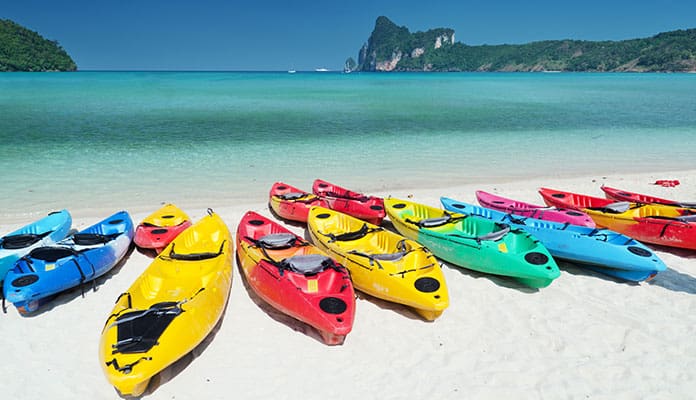
Kayak Length
Generally speaking, ocean kayaks are longer than recreational pond and lake kayaks. This added length makes an ocean kayak much easier to paddle, which is a welcome feature when battling ocean currents. True sea kayaks are over 14 feet long, giving them extra speed to cover larger distances.
Pro Tip: Make sure that you have a way to haul this long kayak, as kayak trailers often have length restrictions.
Hull Width
In large part, choosing the width comes down on your skills as an ocean kayaker. A wider ocean kayak (30+ inches) will provide more stability, which is great if you’re a beginner. However, this extra stability means a reduction in speed, so experienced kayakers usually go with a narrower kayak to boost performance when kayaking on the ocean.
Tracking (Rudders and Skegs)
Even though maneuverability isn’t a huge concern in ocean waters (not many obstacles), currents can create a problem and drag you off your course. To improve tracking in these circumstances, the best ocean kayaks will often come with skegs or rudder systems that will help you paddle in a straight line.
Strength & Durability
Rough waters can have a huge impact on your kayak, so you want to make sure it’s made well. Most top-quality sea kayaks are made of high-density polyethylene using the rotomolding process, so the chances of getting damaged are reduced to a minimum.
Position In The Water
Compared to lake kayaks, ocean kayaks should sit in the water a bit lower. This low center of gravity helps improve stability, which presents significant help when you’re getting rocked by waves. A low-riding ocean kayak will ensure that you can get back to shore safely, despite any crosswinds.
Cockpit Size
For touring the open waters, a sit-inside kayak is usually a better option because of its speed. However, always pay attention to the cockpit design and size, and whether you can fit comfortably inside.
Many people find them claustrophobic, which is why we’ve included several sit-on-top kayak options (including our top pick), so you have options when choosing.
Intended Use
Ultimately, your choice will depend on how you plan to use the kayak. If you enjoy recreational paddling and occasional fishing, the best ocean kayak would be a sit-on-top kayak (it offers more freedom and storage space). But, if you plan to go on multi-day trips, we recommend that you get a sit-in model.
You might also like:
FAQs
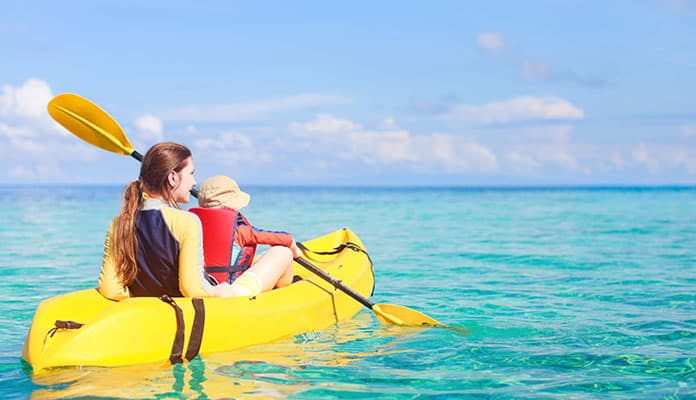
Q: How To Kayak In The Ocean?
Ocean kayaking is very exciting, but requires a higher level of attention and safety precautions. Here is a short list of things you should do when setting out in the open water:
- Get to know the kayak well and get comfortable with it
- Always wear your personal flotation device (PFD) when on the kayak
- Try to keep within swimming distance from the shore (if something unexpected happens)
- Check the water conditions before setting out (ocean water is cold, lower than 32°F can cause hypothermia)
- Understand tides and ocean currents so you don’t get pulled away.
Q: What Is An Ocean Kayak?
Ocean kayaks are vessels specially designed to tackle conditions on the open water. Compared to regular recreational kayaks, sea kayaks are longer, have a lower center of gravity, and offer superior tracking in the ocean water.
Q: What Is The Right Size For A Kayak For Ocean Fishing?
A fishing kayak puts an accent on stability rather than speed, so most sea kayaks for fishing have more or less standard dimensions (like regular fishing kayaks). This means a kayak length between 10 and 12 feet long, and a width between 30 and 35 inches.
Q: How To Anchor A Kayak In The Ocean?
With some practice, anchoring the kayak in the ocean won’t be a problem. To do this, you’ll need an anchor, an anchor line, and a foam float.
- Attach a nylon line to the anchor (50 to 100 feet should be enough)
- Put the foam float on the other end of the line (allows you to dump the anchor and retrieve it)
- When setting up the anchor, open the flukes completely and cast it away from the kayak
- Let it sink to the bottom and tug on the line to make sure it's secure
- Tie the line to the kayak, preferably in the figure 8 pattern so it stays secure.
Q: What Kind Of Kayak Is Best For The Ocean?
The best saltwater kayak is designed to tackle the conditions when kayaking in the sea. A kayak in ocean needs to track well (doesn’t get pulled by currents), have good secondary stability (won’t get topped by waves), and have sufficient length so it can cover larger distances.
Q: Are Sit On Top Kayaks Good For The Ocean?
Yes, sit on tops are good for the ocean. However, you need to pay attention and get a well-designed kayak that can handle these waters. Also, make sure to follow safety precautions when kayaking on the sea, regardless of the type you choose.
Q: Is It Dangerous To Kayak In The Ocean?
Yes, kayaking in the ocean can be dangerous. Because of this, we advise that you always use ocean-specific kayaks that can tackle the waves and currents. Otherwise, you might get pulled away or toppled over, which can leave you in a very nasty situation.
Globo Surf Overview
Exploring the seas in a kayak is incredibly rewarding, but you’ll need the right kayak if you’re to safely enjoy ocean kayaking. Using the tips from our reviews and guide, we hope that you’ll be able to find the best sea kayak that will give you confidence and comfort on every adventure.



